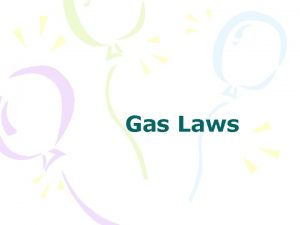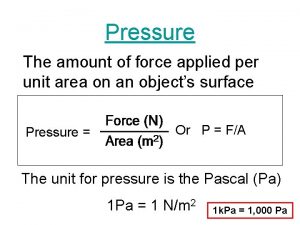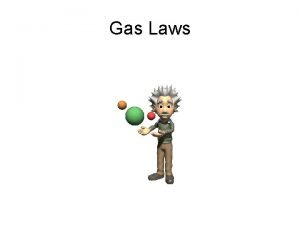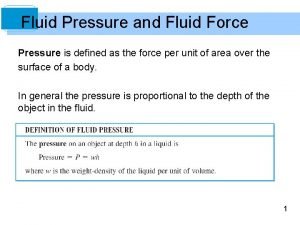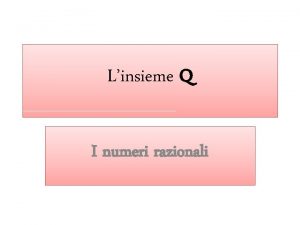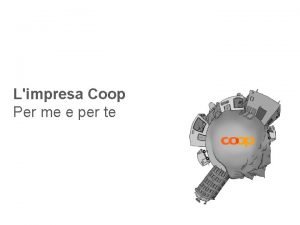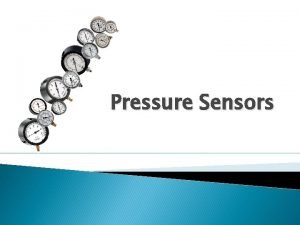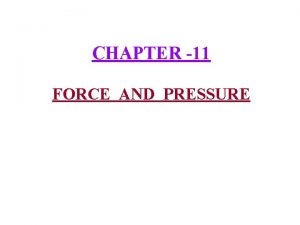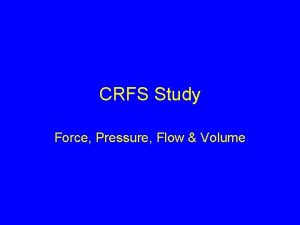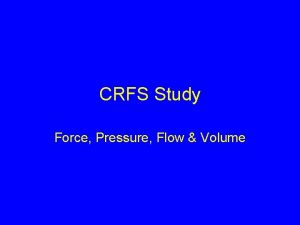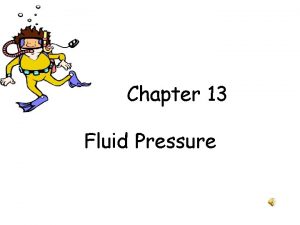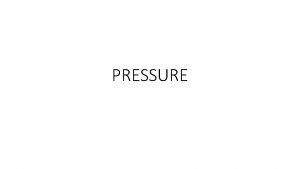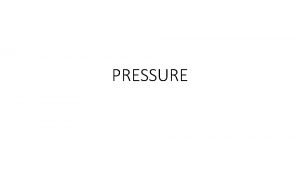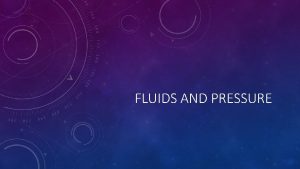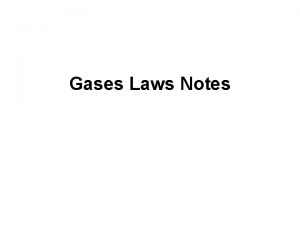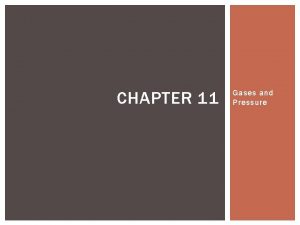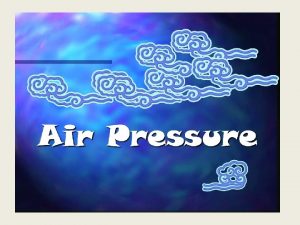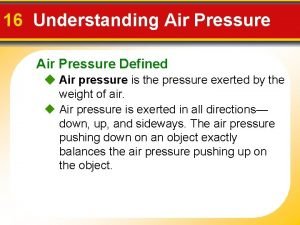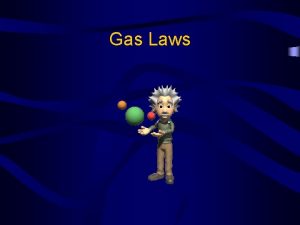Pressure Pressure is defined as the force per



























- Slides: 27

Pressure

Pressure is defined as the force per unit area in a gas or a liquid. For a solid the quantity force per unit area is referred to as stress. In the metric system the pressure is measured in dynes per square centimeter or Newton per square meter; the SI unit for the latter is the Pascal (Pa). None of these units is in commune use in medicine. The most common method of indicating pressure in medicine is by the height of a column of mercury (Hg). For example, a peak (systolic) blood pressure reading of 120 mm. Hg indicates that a column of mercury of this height has a pressure at its base equal to the patient's systolic blood pressure

The pressure P under a column of liquid can be calculated from this formula: P=p g h Where p is the density of the liquid, g is the acceleration due to gravity, and h is the height of the column. Example: What height of water will produce the same pressure as 120 mm. Hg? P (120 mm. Hg) =pgh = (13. 6 g/cm 3) (980 cm/sec 2) (12 cm) For water: =1. 6 * 105 dyne/cm 2 1. 6 * 105 dynes/cm 2= (1. 0 g/cm 3) (980 cm/sec 2) (h cm H 2 O) h=163 cm. H 2 O

Or PHg = Pwater (p gh)Hg = (p gh) water p Hg h. Hg = p water hwater = ( p Hg h. Hg ) / p water =(13. 6 * 12)/1=163 cm. H 2 O

Note: 1 atmosphere (atm) = 1. 01 * 105 N/m 2 1 atmosphere (atm) = 1033 cm. H 2 O 1 atmosphere (atm) =760 mm. Hg 1 cm. H 2 O =0. 735 mm. Hg or 1 mm. Hg = 1. 36 cm. H 2 O Example: calculate the atmospheric pressure in N/m 2 and in dyne/cm 2 , where p Hg =13. 6 g/cm 3? 1 atm =760 mm = 76 cm =0. 76 m p Hg =13. 6 g/cm 3 or 13600 Kg/m 3 The atmospheric pressure in N/m 2 is equal P = p g h =13600 Kg/m 3 * 9. 8 m/sec 2 * 0. 76 m P=101292. 8 N/m 2 The atmospheric pressure in dyne/cm 2 is equal P = p g h =13. 6 g/cm 3 * 980 cm/sec 2 * 76 cm P=1012928 dyne/cm 2

There are two type of pressure: 1 -Gauge pressure: The excess pressure over the atmospheric pressure. 2 -Negative pressure: pressure that lower than the atmospheric pressure. For example: 1 -The lung pressure during inspiration is typically a few centimeters of water negative. 2 - A person drinks through a straw the pressure in his mouth must be negative by an amount equal to the height of his mouth above the level of the liquid he is drinking. There a number of places in the body where the pressures are lower than the atmospheric pressure or negative. For example, When we breathe in (inspire) the pressure in the lung must be somewhat lower than atmospheric pressure or the air would not flow in.

Measurement of pressure in the body The classical method of measuring pressure is to determine the height of a column of liquid that produces a pressure equal to the pressure being measured. An instrument that measures pressures is called a manometer. A common type of manometer is a U-shaped tube containing a fluid that is connected to the pressure to be measured. The levels in the arms change until the difference in the levels is equal to the pressure. This type of manometer can measure both positive and negative pressures. The most common clinical instrument used in measuring pressure is the Sphygmomanometer, which measures blood pressure. types of pressure gauges are used in Sphygmomanometers: 1 - A mercury manometer type: the pressure is indicated by the height of a column of mercury inside a glass tube. 2 - An aneroid type: the pressure changes the shape of a sealed flexible container, which causes a needle to move on a dial.

Pressure inside the skull The brain contains approximately 150 cm 3 of cerebrospinal fluid (CSF) in a series of interconnected openings called ventricles. CSF is generated inside the brain and flows through the ventricles into the spinal column and eventually into the circulatory system. One of the ventricles, the aqueduct, is especially narrow. If at birth this opening is blocked for any reason, the CSF is trapped inside the skull and increases the internal pressure. The increased pressure causes the skull to enlarge. This serious condition, called hydrocephalus (water head); it can often be corrected by surgically installing a by-pass drainage system for the CSF.

Method of measurement the CSF pressure directly: 1 -Crude method of detecting hydrocephalus is to measure the circumference of the skull just above the ears. Normal values for newborn infants are from (3237 cm) and a large value may indicate hydrocephalus. 2 -Transillumination makes use of the light –scattering properties of the rather clear CSF inside the skull.

Eye pressure The clear fluids in the eyeball (the aqueous and vitreous humors) that transmit the light to the retina (the light sensitive part of the eye), are under pressure and maintain the eyeball in a fixed size and shape. The dimensions of the eye are critical to good vision-a change of only 0. 1 mm in its diameter has a significant effect on the clarity of vision. The pressure in normal eyes ranges from 12 -23 mm. Hg. The fluid in the front part of the eye, the aqueous humor, is mostly water. The eye continuously produces aqueous humor and a drain system allows the surplus to escape. If a partial blockage of this drain system occurs, the pressure increases and the increased pressure can restrict the blood supply to the retina and thus affect the vision. This condition, called glaucoma, produces tunnel vision in moderate cases and blindness in severe cases. Early physicians estimated the pressure inside the eye by "feel" as they pressed on the eye with their fingertips. Now pressure in the eye is measured with several different instruments, called tonometers.

Pressure in the digestive system The body has an opening through it. This opening, the digestive tract, is rather tortuous; it extends over 6 m from the mouth to the anus. Most of the time it is closed at the lower end and has several other restrictions. The valves are designed to permit unidirectional flow of food. With some effort it is possible to reverse the flow, such as during vomiting. The pressure is greater than atmospheric in most of the gastrointestinal (GI) system. However, in the esophagus, the pressure is coupled to the pressure between the lungs and chest wall (intrathoracic pressure) and is usually less than atmospheric. During eating the pressure in the stomach increases as the walls of the stomach are stretched. However, since the volume increases with the cube of the radius (R 3) while the tension (stretching force) is proportional to R, the increase in pressure is very slow. A more significant increase in pressure is due to air swallowed during eating. Air trapped in the stomach causes burping or belching. This trapped air is often visible on an X-ray of the chest.

One valve, the pylorus, prevents the flow of food back into the stomach from the small intestine. Occasionally a blockage forms in the small or large intestine and pressure builds up between the blockage and the pylorus; if this pressure becomes great enough to restrict blood flow to the critical organs, it can cause death. Intubation, the passing of a hollow tube through the nose, stomach, and pylorus, is usually used to relieve the pressure. The pressure in the digestive system is coupled to that in the lungs through the flexible diaphragm that separates the two organs systems. When it is necessary or desirable to increase the pressure in the gut, such as during defecation, a person takes a deep breath, closes off the lungs at the glottis(vocal cord), and contracts the abdominal muscles.

Pressure in the urinary bladder One of the most noticeable internal pressures is the pressure in the bladder due to accumulation of urine. Figure 1 shows the typical pressure-volume curve for the bladder, which stretches as the volume increases. For adult, the typical maximum volume in the bladder before voiding is 500 ml. At some pressure (~30 cm. H 2 O) the micturition (gotta go) reflex occurs. The resulting sizable muscular contraction in the bladder wall produces a momentary pressure of up to 150 cm. H 2 O. Normal voiding pressure is fairly low (20 to 40 cm. H 2 O), but for men who suffer from prostatic obstruction of the urinary passage it may be over 100 cm. H 2 O.

Figure 1: The typical pressure-volume relationship in the urinary bladder.

The pressure in the bladder can be measured by: 1 -By passing a catheter with a pressure sensor into the bladder through the urinary passage (urethra). 2 -By a needle inserted through the wall of the abdomen directly into the bladder. This technique gives information on the function of the exit valves (sphincters) that cannot be obtained with the catheter technique. The bladder pressure increases during coughing, straining, and sitting up. During pregnancy, the weight of the fetus over the bladder increases the bladder pressure and causes frequent urination

Pressure effects while diving Since the body is composed primarily of solids and liquids, which are nearly incompressible, pressure changes do not greatly affect most of it. However, there are gas cavities in the body where sudden pressure changes can produce profound effects. To understand why, we must recall Boyle's law; for a fixed quantity of gas at a fixed temperature the product of the absolute pressure and volume is constant (PV=constant). That is, if the absolute pressure is doubled. The volume is halved. Example: What volume of air at an atmospheric pressure of 1. 01 * 105 N/m 2 is needed to fill a 14. 2 liter scuba tank to a pressure of 1. 45 * 107 N/m 2? P 1 V 1=P 2 V 2 (1. 01 * 105) (V 1) = (1. 45 * 107) (14. 2) V 1=2 * 103 liters

The middle ear is one air cavity that exists within the body. For comfort the pressure in the middle ear should equal the pressure on the outside of the eardrum. This equalization is produced by air flowing through the Eustachian tube, which is usually closed except during swallowing, chewing, and yawning. When diving, many people have difficulty obtaining pressure equalization and feel pressure on their ears. A pressure differential of 120 mm. Hg across the eardrum, which can occur in about 1. 7 m of water, can cause the eardrum to rupture. One method of equalization used by a diver is to raise the pressure in the mouth by holding the nose and trying to blow out.

A less serious condition is sinus squeeze. During a dive the pressure in the sinus cavities in the skull usually equalizes with the surrounding pressure. If a diver has a cold, the sinus cavities may become closed off and not equalize, causing pain. Another pressure effect is pain during and after dives from small volumes of air trapped beneath fillings in the teeth. Eye squeeze can occur if goggles are used instead of a facemask; with a facemask the air exhaled from the lungs increases the pressure over the eyes as the descent is made.

If a scuba diver at a depth of 10 m holds his breath and comes to the surface, the air volume will expand by a factor of two and thus cause a serious pressure rise in the lung. If the lungs are filled to capacity, an ascent of only 1. 2 m can cause serious lung damage. All scuba divers learn during training to avoid breath-holding during ascent and to exhale continuously if a rapid ascent is necessary.

The pressure in the lung at any depth is greater than the pressure in the lungs at sea level. This means that the air in the lungs is more dense underwater and that the partial pressures of all the air components are proportionately higher. The higher partial pressure of oxygen causes more oxygen molecules to be transferred into blood, and oxygen poisoning results if the partial pressure of oxygen gets too high. Usually oxygen poisoning occurs when the partial pressure of oxygen is about 0. 8 atm (when the absolute air pressure is about 4 atmospheres), or at a depth of about 30 m.

Breathing air at a depth of 30 m is also dangerous because it may result in excess nitrogen in the blood and tissues. This can produce two serious problems: 1 -Nitrogen narcosis, which is an intoxication effect 2 -The bends, or decompression sickness, which is an ascent problem. While oxygen is transported primarily by chemical attachment to the red blood cells, nitrogen is dissolved in the blood and tissues. According to Henry's law (the amount of gas that will dissolve in a liquid is proportional to the partial pressure of the gas in contact with the liquid).

Other problems can occur during ascent. One of the membranes that separate air and blood in the lung can burst; allowing air to go directly into the bloodstream (air embolism). Air can also become trapped under the skin around the base of the neck or in the middle of the chest. In addition, pneumothorax(lung collapse) can result if air gets between the lungs and the chest wall

Hyperbaric oxygen therapy (HOT) The body normally lives in an atmosphere that is about one-fifth oxygen and four-fifths nitrogen. In some medical situations it is beneficial to increase the proportion of oxygen in order to provide more oxygen to the tissues. To greatly increase the amount of oxygen, medical engineers have constructed special high pressure (hyperbaric) oxygen chambers. Some are just large enough for a patient, while others are large enough to serve as operating rooms.

Hyperbaric oxygen chamber use in 1 - Gas gangrene : The bacillus that causes gangrene cannot survive in the presence of oxygen, almost all gas gangrene patients treated with HOT are cured without the need for amputation. 2 - Carbon monoxide poisoning: The red blood cell cannot carry oxygen to the tissues because the carbon monoxide fastens to the hemoglobin at the places normally used by oxygen. The presence of even a few carbon monoxide molecules on a red blood cell greatly reduces the ability of the cell to transport oxygen.

Normally the amount of oxygen dissolved in the blood is about 2% of that carried on the red blood cells. With HOT, the partial pressure of oxygen can be increased by a factor of 15, permitting enough oxygen to be dissolved to fill the body's needs. 3 - Treatment of cancer: The patient was placed inside a transparent plastic tank, and the radiation was beamed through the walls into the tumor. The theory was that more oxygen would make the poorly oxygenated radiationresistant cells in the center of the tumor more susceptible to radiation damage.

A patient receives treatment with Hyperbaric oxygen chamber

Hazard of HOT 1 - The oxygen atmosphere makes fire a much greater hazard. 2 - Risk of rupture of the tank due to the high pressures used.
 Pressure is force per unit area
Pressure is force per unit area A water glass sitting on a table weighs 4n
A water glass sitting on a table weighs 4n What is the collection of well-defined objects
What is the collection of well-defined objects How is gas pressure defined
How is gas pressure defined Pressure is defined as
Pressure is defined as Approssimazione per difetto e per eccesso
Approssimazione per difetto e per eccesso Coop per te
Coop per te Il mio diletto è per me e io per lui significato
Il mio diletto è per me e io per lui significato Nei šertas nei girdytas o diena dienon tunka
Nei šertas nei girdytas o diena dienon tunka 186 282 miles per second into meters per second
186 282 miles per second into meters per second 60 secondes 1 minute
60 secondes 1 minute 4 km + 3 hm + 2 dam =
4 km + 3 hm + 2 dam = Per stirpes v per capita
Per stirpes v per capita Multas per gentes et multa per aequora vectus
Multas per gentes et multa per aequora vectus Longum iter est per praecepta breve per exempla
Longum iter est per praecepta breve per exempla Per capita vs per stirpes
Per capita vs per stirpes Multās per gentēs et multa per aequora vectus
Multās per gentēs et multa per aequora vectus Electromagnet observation
Electromagnet observation Dalbo stress breaker
Dalbo stress breaker Hát kết hợp bộ gõ cơ thể
Hát kết hợp bộ gõ cơ thể Slidetodoc
Slidetodoc Bổ thể
Bổ thể Tỉ lệ cơ thể trẻ em
Tỉ lệ cơ thể trẻ em Chó sói
Chó sói Tư thế worms-breton
Tư thế worms-breton Hát lên người ơi
Hát lên người ơi Môn thể thao bắt đầu bằng từ đua
Môn thể thao bắt đầu bằng từ đua Thế nào là hệ số cao nhất
Thế nào là hệ số cao nhất
